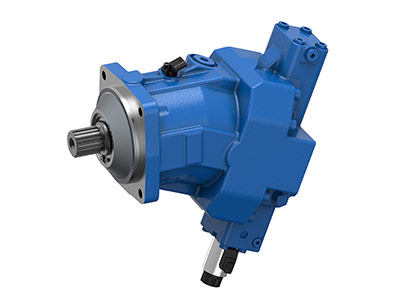As it highlighted its system options along with its technologies for electrification at IFPE last month, Bosch Rexroth showcased new and legacy products that can optimize modern machines. One such component was its A36VM axial piston variable motor, which was developed specifically for hydrostatic drivetrains. It allows greater tractive force and speed for mobile machines.
 The A26VM is a solution for electronically controlled hydrostatic drivetrains, with swiveling range up to 38°, and maximum pressure increased to 530 bar. It has been optimized for existing vehicle architectures.
The A26VM is a solution for electronically controlled hydrostatic drivetrains, with swiveling range up to 38°, and maximum pressure increased to 530 bar. It has been optimized for existing vehicle architectures.
An increased swiveling range and a maximum pressure of 530 bar make mobile machines more efficient while also providing for quicker acceleration. Travel speeds of up to 40 km/h are possible without the need for a shift of a gearbox. The swiveling range at a nominal size of 125 cm3 is 5-38°, while 5°-36° is possible in the 255 cm3 version.
Although it looks like its old A6 motor, Terry Hershberger, Director, Sales – Mobile Hydraulics Technology Leader, noted that it offers more range. “Because we don’t have to have more gearbox shifts, we’re going to give a little bit more range,” he said. “We get more operational range and it allows the machine to be faster, so again, better cycle times, cost of ownership, optimization of fuel.”
Ever quicker, more flexible mobile machines are needed nowadays. Whether they are on a road or at their place of use – construction machinery, agricultural machines and municipal vehicles can be used more economically if they have greater tractive force and speed. In the past this was only possible with an additional shift of a gearbox, but now is easily possible with the new axial piston variable motor from Bosch Rexroth. The A36VM is based on the proven A6VM motor but is optimized specially for the challenges posed by drivetrains.
The A6VM from Bosch Rexroth, which has proven itself for over 30 years, serves as a basis for the new A36VM axial piston variable motor. This was specially adapted and improved to meet the needs of drivetrains. The swiveling range was increased – with a nominal size of 125 cm3 the range is 5-38°, while 5°-36° is possible with a nominal size of 255 cm3. The control and shifting of the swiveling valve make the A36VM more efficient, which now also features fewer sealing points. Furthermore, the geometry was optimized in close consultation with axle and vehicle manufacturers. The outer dimensions as well as the position of the control valves and sensors enable the system to fit seamlessly into tight spaces and existing vehicle architectures.
The BODAS eDA software allows the mobile machine to be optimally tailored in terms of power and fuel consumption. In addition, diesel overspeed protection, overheating protection and diesel load limiting control are integrated into the drivetrain software. This helps to ensure a long machine operating life. Driving modes tailored to specific applications allow load-sensing or proportional travel, aggressive acceleration, or sensitive positioning. There are also comprehensive diagnostic options and defined emergency operation strategies, as well as convenient functions such as creep modes or speed limiting modes.
The displays showcased two solutions — electronic open circuit (EOC) or electric closed circuit (ECC) for hydrostats. This gives Rexroth the range to manage steady battery flows and output power with its BODAS or hydraulic solutions. “This is exciting from an electrification or hydraulic world,” said Hershberger. “We’re not going to be all electric by 2030. We’re not going to be there for sure.”
Bosch Rexroth
www.boschrexroth-us.com/tmm
Filed Under: Components Oil Coolers, Mobile Hydraulic Tips, Pumps & Motors, Trending